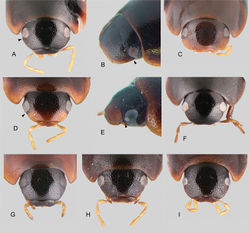| Notice: |
This page is derived from the original publication listed below, whose author(s) should always be credited. Further contributors may edit and improve the content of this page and, consequently, need to be credited as well (see page history). Any assessment of factual correctness requires a careful review of the original article as well as of subsequent contributions.
If you are uncertain whether your planned contribution is correct or not, we suggest that you use the associated discussion page instead of editing the page directly.
This page should be cited as follows (rationale):
Girón J, Short A (2021) Review of the Neotropical water scavenger beetle genus Tobochares Short & García, 2007 (Coleoptera, Hydrophilidae, Acidocerinae): new lineages, new species, and new records. ZooKeys 1019 : 93–140, doi. Versioned wiki page: 2021-02-22, version 189005, https://species-id.net/w/index.php?title=Tobochares_communis&oldid=189005 , contributors (alphabetical order): Pensoft Publishers.
Citation formats to copy and paste
BibTeX:
@article{Girón2021ZooKeys1019,
author = {Girón, Jennifer C. AND Short, Andrew Edward Z.},
journal = {ZooKeys},
publisher = {Pensoft Publishers},
title = {Review of the Neotropical water scavenger beetle genus Tobochares Short & García, 2007 (Coleoptera, Hydrophilidae, Acidocerinae): new lineages, new species, and new records},
year = {2021},
volume = {1019},
issue = {},
pages = {93--140},
doi = {10.3897/zookeys.1019.59881},
url = {https://zookeys.pensoft.net/articles.php?id=59881},
note = {Versioned wiki page: 2021-02-22, version 189005, https://species-id.net/w/index.php?title=Tobochares_communis&oldid=189005 , contributors (alphabetical order): Pensoft Publishers.}
}
RIS/ Endnote:
Wikipedia/ Citizendium:
See also the citation download page at the journal. |
Taxonavigation
Ordo: Coleoptera
Familia: Hydrophilidae
Genus: Tobochares
Name
Tobochares communis species group – Wikispecies link – Pensoft Profile
Diagnosis
The Tobochares communis species group can be recognized by the straight anterior margin of the eye in lateral view (e.g., Fig. 2E), the usually longitudinally aligned elytral punctures, the short and narrow glabrous patch on the metaventrite (Fig. 3D, E), the high density of the hydrofuge pubescence on the abdominal ventrites, and the well-developed and numerous metatibial spines.
Composition
Tobochares akoerio sp. nov., T. arawak sp. nov., T. anthonyae sp. nov., T. atures sp. nov., T. canaima sp. nov., T. communis sp. nov., T. kappel sp. nov., T. kolokoe sp. nov., T. microps sp. nov., T. pemon sp. nov., and T. romanoae sp. nov.
Taxon Treatment
- Girón, J; Short, A; 2021: Review of the Neotropical water scavenger beetle genus Tobochares Short & García, 2007 (Coleoptera, Hydrophilidae, Acidocerinae): new lineages, new species, and new records ZooKeys, 1019: 93-140. doi
Images
| Figure 3. Characters of elytra and wings of Tobochares spp. A–E Scanning Electron Micrographs A–C elytra: white arrows point to serial punctures; black arrows point to interserial punctures AT. communisBT. aturesCT. arawakD, E ventral view of mesoventrite: DT. communis: top white arrow points to posterior elevation of mesoventrite with low longitudinal elevation; bottom white arrow points to narrow longitudinal glabrous patch of the metaventrite ET. arawak: top white arrow points to posterior elevation of mesoventrite with weakly elevated bulge; bottom white arrow points to narrow longitudinal glabrous patch of the metaventrite. F–I detail of elytral punctation; black marks at top of each circle indicates serial punctures FT. pemon (all punctures relatively large; serial punctures longitudinally aligned; interserial punctures in irregular single row) GT. atures (all punctures longitudinally aligned; serial punctures larger than interserial punctures; interserial punctures more densely distributed) HT. kolokoe (serial punctures longitudinally aligned; interserial punctures forming one or two irregular rows) IT. canaima (serial punctures longitudinally aligned; interserial punctures forming two or three irregular rows) J, K hindwings JT. sipaliwiniKT. microps. |
|

